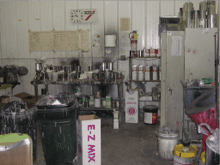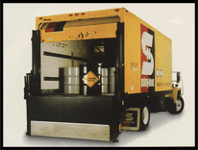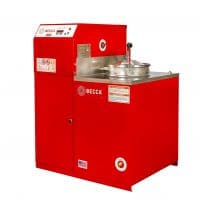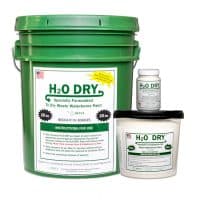 |
 |
 Options To Eliminating Hazardous Waste
Options To Eliminating Hazardous Waste
Shops with waste paint produce a large waste stream consequently removal for paint shops is costly. Common areas of EPA fines lie in the storage of waste paint. Accruing waste paint in an improper environment is a violation of code according to Occupational Safety and Health Administration (OSHA) and the Environmental Protection Agency’s (EPA) standards. Improperly stored waste paint results in fines that could amount to thousands possibly even hundreds of thousands of dollars, according to the Federal Register, the U.S. Federal Government’s regulation of federal agencies, 40 CFR 265.173(a) and (b). Therefore it is important to ensure that any shop using paint is properly disposing of the waste.
Several options to eliminate hazardous waste for spray gun cleaning operations including:
- Hazardous Waste Removal Services

- Recycling
- Distillation with Vacuum Assist
- Filtration
- Flocculation with Filtration
- Dried to Waste
- Absorbents
Options For Hazardous Waste Paint Removal
-
Hazardous Waste Removal Services
Hazardous Waste Removal Services come to your facility to retrieve your hazardous waste. These services deal with the waste in their own methods.
-
Recycling
Recycling is a form of extracting paint waste and reusing the recovered liquid. There are multiple methods of recycling. These methods include distillation with vacuum assist, filtration, and flocculation with filtration. See brief definitions below.
-
Distillation With Vacuum Assist
 This process extracts the remaining water from waterborne waste paint using a solvent distillation unit (recycler). This process successfully removes 100% of paint waste from the liquid. While a solution for waterborne waste paint it is not an economical solution. Time and money are large issues that arise when using a recycler for waterborne waste paint. A long process taking up to a day to complete the distillation process. Money is the other issue. These recyclers cost anywhere from $3,000 to $50,000. Another successful option to distill waterborne waste paint is a vacuum assist. This allows for effective and timely processing of the solvent distillation unit. The expense of a recycling unit does not compensate for the money that is spent on the unit in waterborne recycling. Therefore the return on investment is almost non-existent. There are much more cost-effective methods for recycling waterborne waste paint.
This process extracts the remaining water from waterborne waste paint using a solvent distillation unit (recycler). This process successfully removes 100% of paint waste from the liquid. While a solution for waterborne waste paint it is not an economical solution. Time and money are large issues that arise when using a recycler for waterborne waste paint. A long process taking up to a day to complete the distillation process. Money is the other issue. These recyclers cost anywhere from $3,000 to $50,000. Another successful option to distill waterborne waste paint is a vacuum assist. This allows for effective and timely processing of the solvent distillation unit. The expense of a recycling unit does not compensate for the money that is spent on the unit in waterborne recycling. Therefore the return on investment is almost non-existent. There are much more cost-effective methods for recycling waterborne waste paint. -
Filtration
 Filtration is another method of recycling waterborne waste paint. The filtration process consists of micron filter tubes that filter out the paint in solvent or waterborne paint gun cleaners. Shops primarily converted to waterborne paint, distilling solvents are finding it no longer cost-effective. Therefore filtration is a good option. Filtration is a successful method of reusing liquids, however, there is a possibility of slight coloration in the liquid being filtered. This occurs because the filters only filter out to 25 microns, filtering out approximately 90-95% of the used paint. Adding filtration to a paint gun cleaner may cost anywhere from $700 to $1,500. While filter replacement can cost from $50 to $150 depending on the filter system. The amount of use and care depends on how much a shop will need to replace filters. Filters with proper care may last from 1 to 3 months.
Filtration is another method of recycling waterborne waste paint. The filtration process consists of micron filter tubes that filter out the paint in solvent or waterborne paint gun cleaners. Shops primarily converted to waterborne paint, distilling solvents are finding it no longer cost-effective. Therefore filtration is a good option. Filtration is a successful method of reusing liquids, however, there is a possibility of slight coloration in the liquid being filtered. This occurs because the filters only filter out to 25 microns, filtering out approximately 90-95% of the used paint. Adding filtration to a paint gun cleaner may cost anywhere from $700 to $1,500. While filter replacement can cost from $50 to $150 depending on the filter system. The amount of use and care depends on how much a shop will need to replace filters. Filters with proper care may last from 1 to 3 months. -
Flocculation with filtration
Flocculation with filtration is a process where an absorbent is poured into the waterborne waste created by gun cleaners. As a result, the absorbent causes the paint material to clump together. Once stirring and pouring the setting water through the micron filter bags, paint material will separate from the water. The water is then good to use again and the remaining waste paint is ready for disposal processes. Flocculation materials cost anywhere from $60 to $230, per container. We recommend that the flocculation process occurs at least once a week.
-
-
Dried To Waste
Dried To Waste, these are compounds which when added to hazardous waste paint solidify the liquid material. Once solidified the material is acceptable for disposal.

- Absorbents are compounds that are added to waste paint resulting in dried and hardened waste. These absorbents dry hazardous materials as well as leaving them non-flammable, thus allowing the material to be disposed of as regular waste. Absorbents are a cost-effective option for paint shops. They supply a quick and easy process for the disposal of hazardous waste (waste paint). Absorbents can be purchased anywhere from $50 to $300 depending on the size of the container. For instance, the lifespan of the absorbents depends on the amount of waste paint being generated.
Upon recycling or adding absorbents to the waste paint solution, allow the hardening process to complete. A hazardous waste test should be done once the process is complete. This will ensure the waste passes the requirements for the TCLP (heavy metals), dryness, and flammability.
Recycling Methods
 Recycling methods including filtration, flocculation with filtration, and absorbents are all excellent solutions for filtering and reusing or disposal of waterborne waste paint. Each method provides cost-effective answers to expensive processes. These processes occur in the everyday functions of any shop using waterborne paints. The compliance of these products with OSHA, EPA, and Federal regulations provides environmental solutions. In addition, they give shops solutions to legal issues concerning paint waste. Using recycling methods or absorbents any shop can avoid the expensive cost of hazardous waste removal services and distillation units.
Recycling methods including filtration, flocculation with filtration, and absorbents are all excellent solutions for filtering and reusing or disposal of waterborne waste paint. Each method provides cost-effective answers to expensive processes. These processes occur in the everyday functions of any shop using waterborne paints. The compliance of these products with OSHA, EPA, and Federal regulations provides environmental solutions. In addition, they give shops solutions to legal issues concerning paint waste. Using recycling methods or absorbents any shop can avoid the expensive cost of hazardous waste removal services and distillation units.

